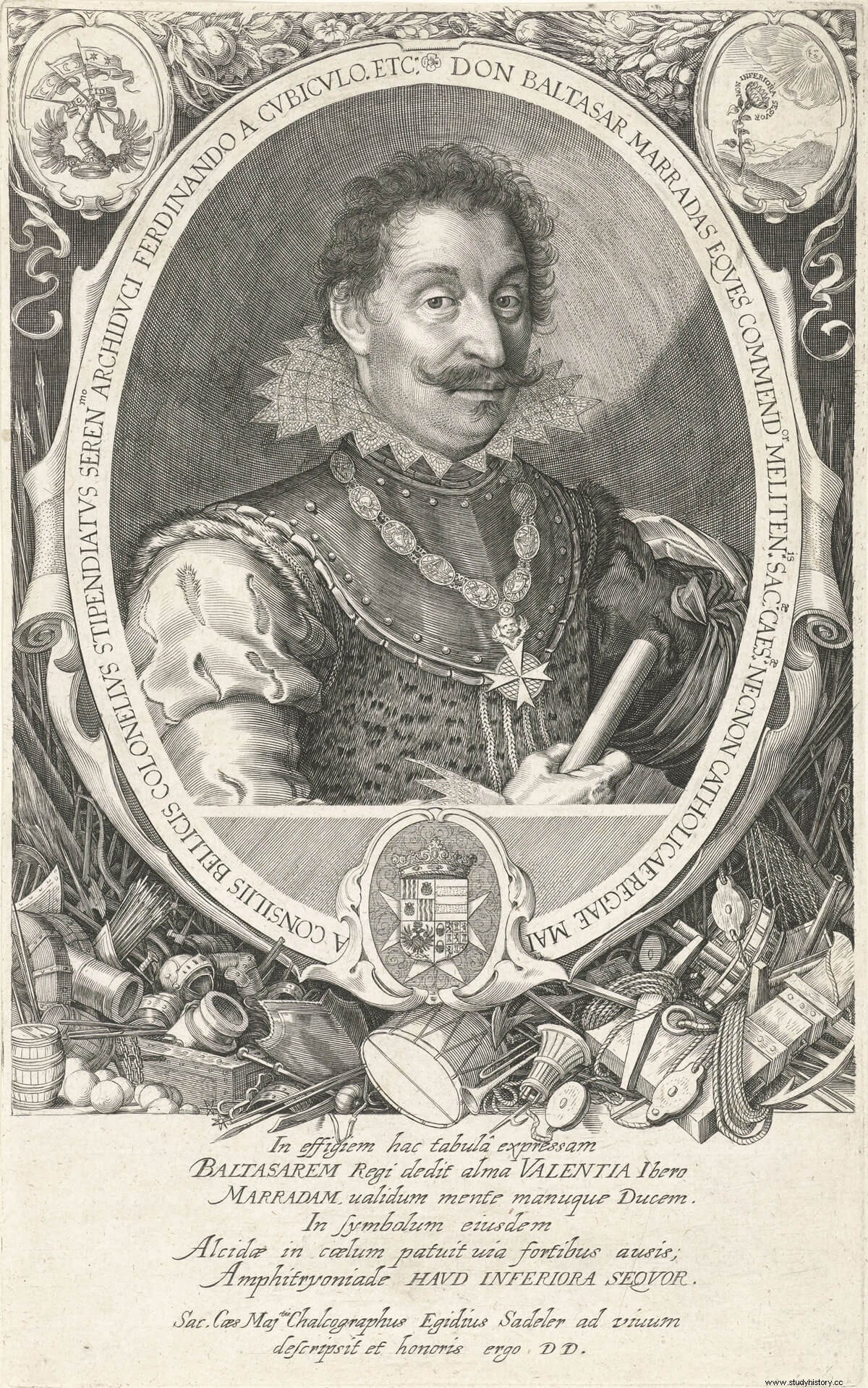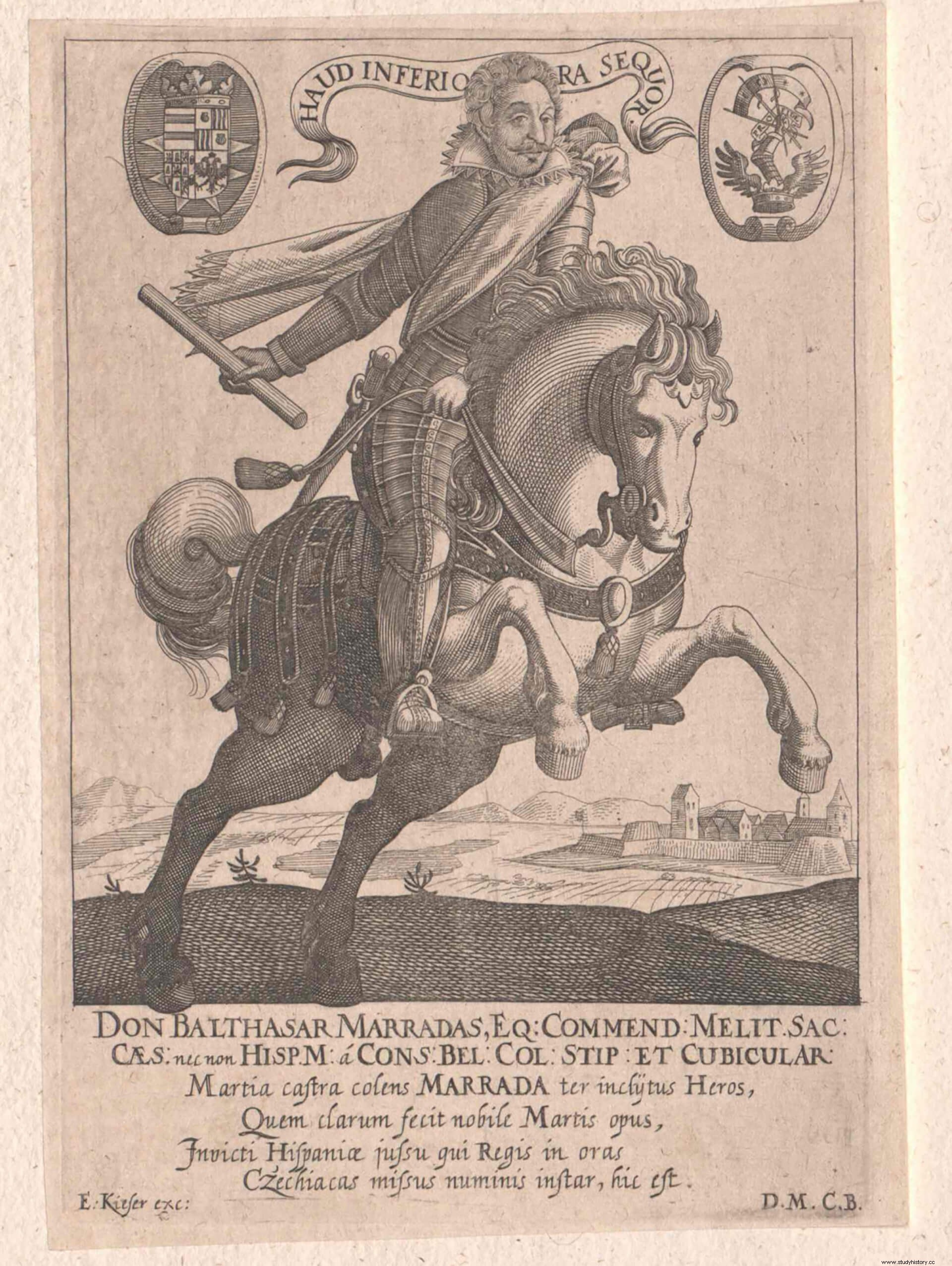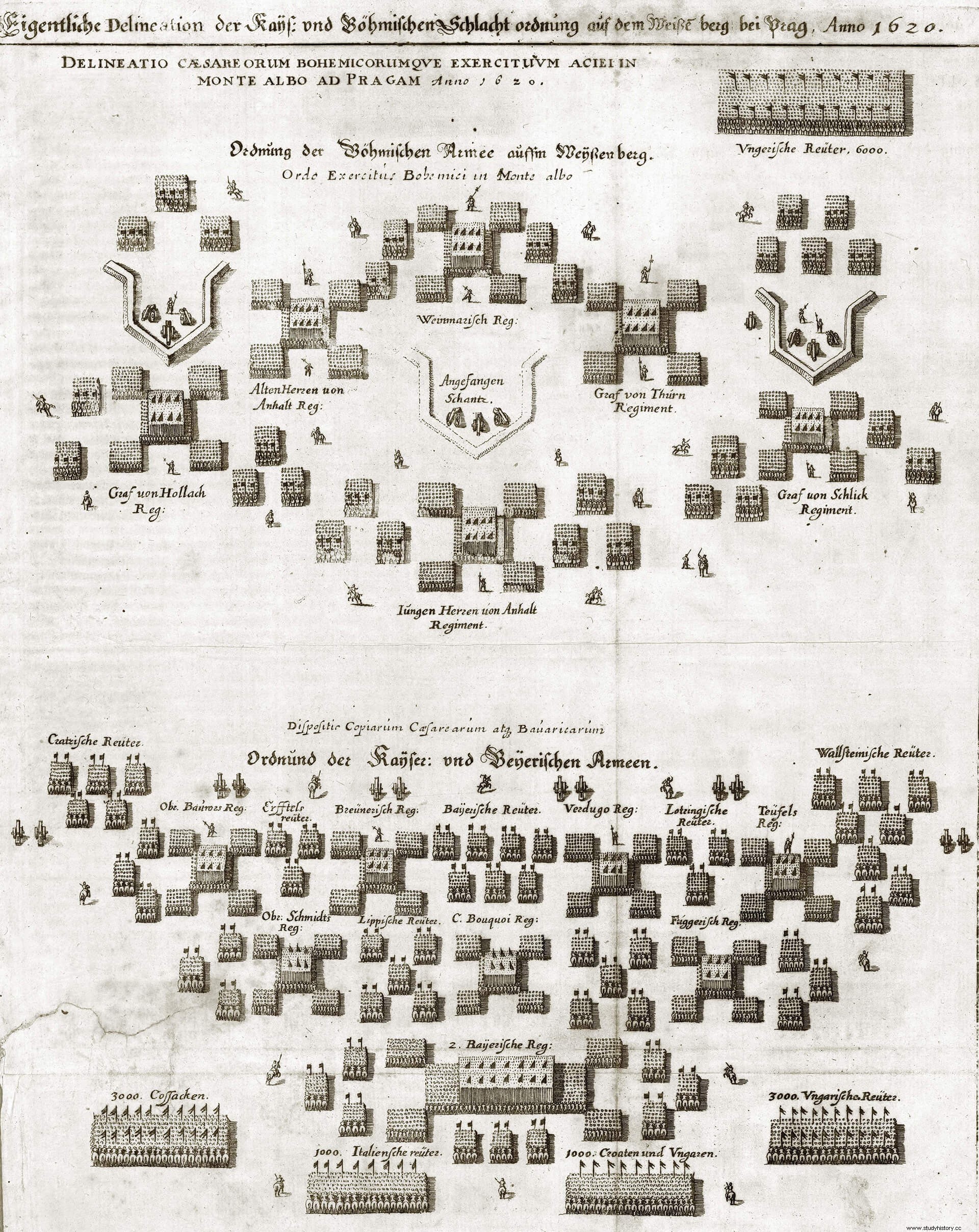In February 1630, the Spanish soldier of fortune Diego Duque de Estrada arrived in Vienna from Transylvania. The imperial ambassador in that principality, with whom he had befriended, presented him in public audience to the Holy Emperor Ferdinand II (1578-1637). In the company of the Habsburg, the Duke of Estrada found another Spaniard, Baltasar de Marradas , whom he describes in his autobiography as "the most noble Valencian gentleman, one of the bravest soldiers that the Spanish nation has had in our ages". Marradas questioned the adventurer and they maintained a friendly conservation. According to the Duke of Estrada, "the emperor was very pleased to hear us speak in Spanish and that we knew each other by fame."

Marradas, when the encounter took place, I already had 70 years old, Holy Roman Count, Lord of Fraumberg (present-day Hluboká, in the Czech Republic), Vogitz (Vožice) and Budian (Vodňany), War Councilor to the Emperor, Knight of his Chamber, Captain of the Archers of his Guard , colonel and captain general of the imperial cavalry, field marshal and governor of Bohemia. Around the same time, he had met another Spaniard, Juan de Palafox y Mendoza, then chaplain and beggar of the Infanta María, sister of Felipe IV and future empress. Palafox wrote about Marradas in his German Political Dialogue that he was “a man of value, executive, ardent, shrewd, more German than themselves, has got away with being considered a natural, and has very good estates and places in Bohemia; love him well, and even the voters themselves.”
Baltasar de Marradas i Vich, born in 1560 into an important family of the Valencian nobility, served the Habsburgs of Vienna since he was 19 years old. Educated in letters, dance, music and horsemanship, as he corresponded to any young man of his condition, he learned the trade of arms in the galleys of the Order of Malta, of which he was knight and commander. . After taking part in various privateering expeditions, he decided to change his mind and entered the court of Emperor Rudolf II (1552-1612) at the hands of his uncle, Guillem de Santcliment, veteran of Lepanto and Spanish ambassador to Germany from 1581 until his death. death in 1608. His rise began with the Long War (1593-1606) , which pitted the Holy Roman Empire against the Ottomans in Hungary and Transylvania. At the Alba Iulia siege he was seriously wounded during the reconnaissance of a battery. For that action he was rewarded with the command of a company of armored horses and, at the end of the conflict, he was already a colonel and sergeant major general.
Baltasar de Marradas had an outstanding role in the Gradisca War (1615-1618) , which faced the Holy Empire and the Republic of Venice in the regions of Friuli and Istria. Commanding two regiments of cuirassiers, one recruited at the behest of Philip III and the other by order of Emperor Matthias (1557-1619), together with a contingent of slaves, he expelled the Venetians from most of Istria in just seventeen days and he defeated them in several clashes. After that he went to the aid of the fortress of Gradisca, besieged by a large Venetian army that counted among its ranks four thousand mercenaries from the United Provinces led by Juan Ernesto de Nassau-Siegen. The same cannonball that killed the Imperial commander, Adam von Trautmannsdorf, seriously wounded Marradas, who nevertheless recovered and took command of the defense of the square. His provisions safeguarded the fortress until Albrecht von Wallenstein arrived with reinforcements and forced the besiegers to withdraw.
The outbreak of the Thirty Years' War
The Defenestration of Prague (May 23, 1618) and the consequent expansion of the revolt of the Protestant nobles of Bohemia forced Matthias to call his best soldiers to Vienna. The imperial offensive against Prague failed because of the defeat at Lomnice (November 8, 1618). Baltasar de Marradas took command of the rearguard in the subsequent retreat and managed to defend a bridge from the harassment of the Bohemian vanguard with barely two hundred cuirassiers and the help of Wallenstein. In this action, which detained the rebels for three days, Marradas suffered seven wounds and lost three horses, according to Duque de Estrada. After the campaign, the Valencian acquired a decisive role. As the crisis escalated with the spread of the revolt to Moravia and Lusatia, Emperor Matthias passed away. With the bulk of the imperial forces isolated in Budweis and Krems, the new ruler, Ferdinand II, was vulnerable in Vienna to the intrigues of the Austrian Protestants. It was Marradas who dispatched Dampierre's regiment to the city, which arrived just in time, on June 5, 1619, and saved the emperor. As a reward, Ferdinand would grant him the lordships of Fraumberg and Budian.

In the campaign of 1619, Marradas, as A subject of the king of Spain and a trusted man of the emperor, he was appointed battle sergeant general of the troops that Felipe III sent to the Empire to help put down the rebellion. The Valencian commanded a body of Walloon troops and supported the Count of Bucquoy in his offensive towards Prague. At the siege of Písek he was slightly wounded by a musket ball. Soon after, the army had to race back to Vienna as the forces of the Count of Thurn, leader of the Bohemian rebels, and his ally, the Transylvanian prince Gabriel Bethlen, approached. Marradas found himself in command of the rearguard again and was tasked with defending a bridge over the Danube at Fischamend, near Vienna, with eight hundred Walloon infantry. He did it for six hours, "sword in hand, shouting «Courage, Walloon soldiers»", according to the chronicler Louis de Haynin (1582-1640), distinguished officer of that nation.
Baltasar de Marradas in White Mountain
Failed the Protestant attempt on Vienna, the imperials went on the counterattack and Marradas, at the head of the army's cavalry, recovered a considerable number of places from Bohemian hands, including Jihlava, Rabensburg and Hohenau. Reinforced the imperial army with Neapolitan and Walloon veterans trained in Italy, whom Marradas went to collect in Passau, and with the forces of the Catholic League, the offensive was unleashed that led to the Battle of the White Mountain . On November 8, 1620, in that decisive victory for the imperialists, Marradas led his regiment of cuirassiers on the left of the second imperial line and contributed to the collapse of the rebel resistance. His loyalty was rewarded early in 1621, once Bohemia, Moravia and Lusatia had been pacified, with the dignity of count and generalship of the imperial cavalry, in addition to the aforementioned lands, requisitioned by the emperor from rebellious nobles. /p>

In 1623 and 1624, Baltasar de Marradas fought in Hungary and Moravia against Gabriel Bethlen, who intended to seize the Hungarian crown but, his attempts unsuccessful, decided to agree with the emperor. From 1625, Marradas served under the imperial generalissimo, Wallenstein. In 1626 he was appointed field marshal and in 1627 he defended Bohemia from attack by the forces of Christian IV of Denmark and his local allies. The Empire apparently pacified with the Peace of Lübeck (1629), it was able to dedicate itself to beautifying its properties and promoting Catholic practice through the arts –particularly the cult of the Virgin of Montserrat– throughout Bohemia, of which it was appointed governor. He also had the opportunity to participate in the celebrations for the wedding of the Infanta María Ana of Spain and Fernando, King of Hungary and future Emperor Fernando III. Three days after the betrothal, a sumptuous parade of floats took place, in which, according to the Duke of Estrada:"The fourth carriage was pulled by two domestic bears, in which, opening a cloud, General Count Don Baltasar de Marradas, sitting on his tripod, representing Mars armed with very strong, expensive and resplendent weapons”.
In 1632 the Valencian had to face the Swedish and Saxon avalanche that followed the battle of Breitenfeld . It was the most difficult moment of his career. Although he had to give up Prague, he made himself strong in Budweis and "with ordinary brokerages he kills and apprehends a large infinity of Saxons", in the terms of the chronicler Fadrique de Moles. The blows of the hand weakened the Saxon forces and allowed them to counterattack and recover several places. Wallenstein, however, was not entirely satisfied and dismissed him. Both because of his loyalty to Fernando II and because of the generalissimo's attitude, Marradas was a participant in the plot that ended with the assassination of the once powerful leader. In 1635, after the Peace of Prague, the Emperor appointed him Governor of Bohemia again. The mischievous Estebanillo González, servant of Cardinal Infante Fernando and General Octavio Piccolomini, would meet him at that time, happy, in Prague:“I found him at the table and, celebrating my good arrival, he gave me to eat and drink even much more than usual. that was enough for me”. The Valencian knight who saved the emperor in 1618 would die a year after him, in 1638, not without leaving a valuable artistic legacy. His is the most successful of the cases of Spanish soldiers of fortune who fought in central Europe in the Thirty Years' War.
